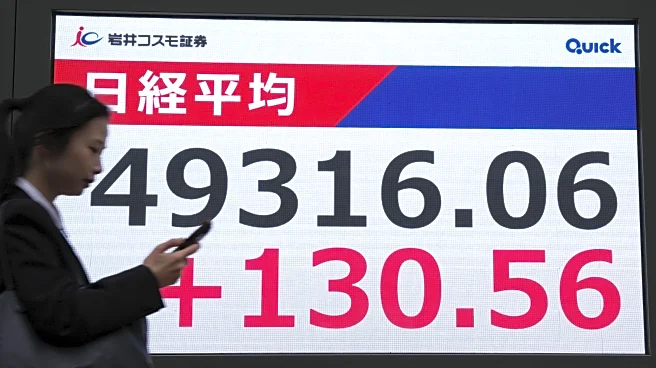What's Happening?
China has become a significant force in driving gold prices to unprecedented levels in 2025. According to Torsten Slok, chief economist at Apollo Global Management, China's impact is multifaceted, involving
central bank purchases, arbitrage trading, and increased demand from Chinese households. Slok's analysis, supported by data, suggests that global central banks may soon hold more gold than U.S. dollars. This development comes amid macroeconomic uncertainties, including a recent sell-off against a strengthening dollar, which saw gold prices drop significantly after reaching a peak. Despite this, gold remains up over 55% year-to-date, driven by factors such as President Trump's tariffs on China, which have disrupted global trade and weakened confidence in the U.S. dollar.
Why It's Important?
The rise in gold prices has significant implications for global economic stability and investor behavior. As the U.S. dollar depreciates and stock markets face volatility, gold is increasingly seen as a safe-haven asset. This shift is not only driven by Chinese demand but also by rising business uncertainty in the U.S., exacerbated by trade tensions and economic volatility. Major financial institutions, including Goldman Sachs, have adjusted their forecasts, predicting further increases in gold prices. This trend reflects a broader move away from the dollar, with both central banks and private investors diversifying their portfolios. The situation draws parallels to the 1970s, suggesting a potential long-term bull market for gold.
What's Next?
The ongoing trade tensions between the U.S. and China are likely to continue influencing gold prices. Upcoming meetings between President Trump and President Xi Jinping could impact future trade policies and economic relations. Additionally, as global economic uncertainties persist, investors may increasingly turn to gold as a hedge against inflation and systemic instability. Analysts predict that if current trends continue, gold prices could reach new heights in the coming years, further altering the landscape of global financial markets.
Beyond the Headlines
The current gold rally highlights deeper economic shifts, including the potential decline of the U.S. dollar's dominance as the world's reserve currency. This shift could have long-term implications for global trade and financial systems. Moreover, the increased demand for gold underscores the growing importance of China in shaping global economic trends. As Chinese consumers and institutions continue to influence markets, their role in the global economy is likely to expand, challenging traditional economic power structures.













